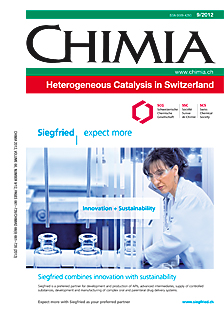Development of Industrial Catalysts for Sustainable Chlorine Production
DOI:
https://doi.org/10.2533/chimia.2012.694Keywords:
Catalytic hcl oxidation, Ceo2, Chlorine recycling, Cu-based catalysts, Supported ruo2Abstract
The heterogeneously catalyzed gas-phase oxidation of HCl to Cl2 offers an energy-efficient and eco- friendly route to recover chlorine from HCl-containing byproduct streams in the chemical industry. This process has attracted renewed interest in the last decade due to an increased chlorine demand and the growing excess of byproduct HCl from chlorination processes. Since its introduction (by Deacon in 1868) and till recent times, the industrialization of this reaction has been hindered by the lack of sufficiently active and durable materials. Recently, RuO2-based catalysts with outstanding activity and stability have been designed and they are being implemented for large-scale Cl2 recycling. Herein, we review the main limiting features of traditional Cu-based catalysts and survey the key steps in the development of the new generation of industrial RuO2-based materials. As the expansion of this technology would benefit from cheaper, but comparably robust, alternatives to RuO2-based catalysts, a nov el CeO2-based catalyst which offers promising perspectives for application in this field has been introduced.Downloads
Published
2012-09-26
Issue
Section
Scientific Articles
License
Copyright (c) 2012 Swiss Chemical Society

This work is licensed under a Creative Commons Attribution-NonCommercial 4.0 International License.
How to Cite
[1]
Chimia 2012, 66, 694, DOI: 10.2533/chimia.2012.694.







